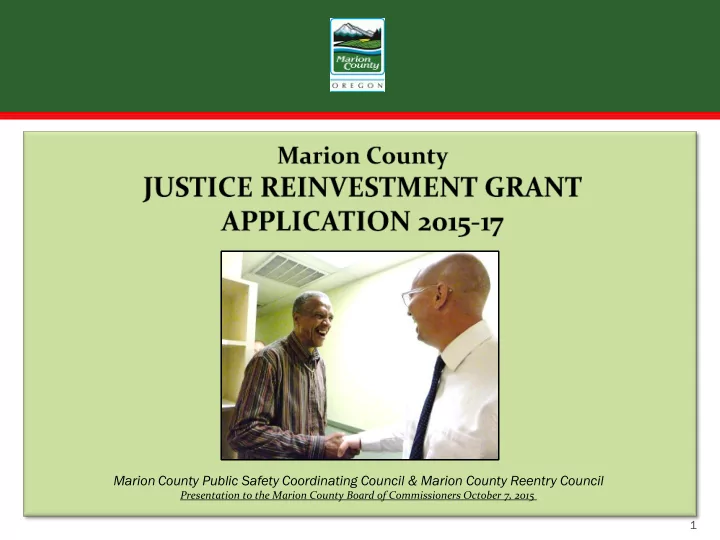

REENTRY INITIATIVES Marion County Public Safety Coordinating Council & Marion County Reentry Council Presentation to the Marion County Board of Commissioners October 7, 2015 1
House Bill 3194 passed in 2013 Creates Justice Reinvestment policy for Oregon Reduces prison costs and avoids new prison construction Focuses on offenders and victims Savings invested in counties to divert property and drug offenders from state prison Grant funds managed by Oregon Criminal Justice Commission First allocation in 2014-15 while rules developed 2
Legislature approved $38.7 million for counties for the 2015-17 biennium Marion County’s biennial allocation is $3,534,081 Grant application released July 15 Applications due October 14 10% dedicated to victims 3% dedicated to statewide evaluation (Randomized Controlled Trials or RCTs) 3
Reduce prison populations Reduce recidivism Increase public safety Increase offender accountability MARION COUNTY Y RECIDI DIVISM ISM RATES ES 2002-2014 4
1. Community-based and evidence-based strategies 2. Local criminal justice system mapping 3. LPSCC collaboration, engaging in Regional Implementation Councils 4. Data to inform decisions 5. Evidence-based programs 6. Law enforcement specialized training 7. Victim services and supports 5
Total community corrections need in Marion County calculated at $36 million annually: ▪ Does not include circuit court and prosecution costs ▪ Full cost of county jail is included in this figure 3,700 on parole and probation in Marion County 600 released from prison to Marion County each year 6
92% of those released from prison are Marion County residents Focus is on clients with high and medium risk, using evidence-based practices in three categories: Prison diversion strategies Recidivism reduction strategies Public safety strategies 7
Law requires local public safety councils to create and submit application Marion County Public Safety Coordinating Council and Marion County Reentry Council spent a year developing both plans Members, representing: Circuit Court Veterans Mental health providers Attorneys State and local law enforcement Substance abuse providers Victim Assistance Cities Housing/shelter providers Sheriff Oregon Youth Authority Community corrections Juvenile Department Public Defender Board of Commissioners Health Department Education Economic development District Attorney Business Community Services Chemeketa Community College Department 8
What are currently-funded JRI services? Are they working? Are there funding gaps for current services? What other programs or services are needed? 9
Par Param ameter er 1: Evidence-based services Par Parameter er 2: Successful existing services highest priority Par Parameter er 3: Filling current service gaps and creating new services considered equally Par Parameter er 4: Council assists non-funded programs (grants, support, advocacy) 10
September 2014 – Joint LPSCC and Reentry Council meetings began June 2015 – In depth strategy presentations completed July 2015 – Prioritization parameters adopted August 2015 – Steering committee met to prioritize strategies September 8, 2015 – LPSCC approved recommended strategies September 22, 2015 – Community Corrections Board endorsed plan October 7, 2015 – Board of Commissioners to consider plan October 13, 2015 – LPSCC to ratify plan October 14, 2015 – Plan submission deadline 11
Contracted Services $ 701,831 $ 701,8 ,831 Reentry Initiatives $ 1, 1, 663,3 3,368 68 $ 1, 1,663, 3,368 68 Prison Diversion Programs $ 9 911,774 $ 9 911,774 Supervision: Foundation $ 3 30,045,101 1 $ 3 30,045,101 TOTAL AL NEED ED $36,096,895 895 12
16-1 BIENNIAL % PROGRAM/SERVICE TOTAL PRISON DIVERSION STRATEGIES Senate Bill 416 Prison Diversion Program $ 1,272,140 Jail Reentry Program $ 476,376 Marion County Adult Drug Court $ 40,000 Potential Protocol Changes $ - 51% SUBTOTAL $ 1,788,516 RECIDIVISM REDUCTION STRATEGIES Link Up $ 223,822 Student Opportunity for Achieving Results (SOAR) $ 461,646 De Muniz Resource Center $ 100,686 Transition Services/Housing $ 126,171 Substance Abuse Treatment $ 228,000 Family Support Program $ 42,060 33% SUBTOTAL $ 1,182,385 PUBLIC SAFETY STRATEGIES Victim Assistance - Bilingual Services $ 100,000 Data System Upgrade $ 3,750 3% SUBTOTAL $ 103,750 87% TOTAL $ 3,074,651 10% Victim Services $ 353,408 3% Statewide Evaluation (RCTs) $ 106,022 100% GRAND-TOTAL $ 3,534,081 13
Senate Bill 416 Prison Diversion Program - $1,272,140 Diverts high and medium-risk property offenders from state prison. 110 clients in 2013-15, 11.3% recidivism rate. Jail Reentry Program - $473,376 90-day treatment and mentoring program, prepares inmates at Work Center. Marion County Adult Drug Court - $40,000 Partially fills budget gap for client urinalysis tests. Potential Protocol Changes - $0 Data presentations to set state for protocol adjustments focused on downward departures and probation revocations. 14
Link Up - $223,822 Mentoring and treatment services for reentry clients with co-occurring mental health and substance abuse disorders. Student Opportunity for Achieving Results (SOAR) - $461,646 Intensive 12-week cognitive-based program on Chemeketa Community College campus. De Muniz Resource Center - $100,686 One-stop reentry resource center assists with employment, identification, housing, education, legal, and basic needs. 15
Transition Services/Housing - $126,171 Rental assistance stipends for an additional 60 clients for up to three months. Substance Abuse Treatment - $228,000 Treatment for reentry clients that addresses addiction and criminogenic risk factors. Family Support Program - $42,060 Focuses on families with young children where family has been impacted by incarceration. 16
Victim Services - $100,000 Bilingual victim advocate will assist with restraining orders and supportive services. Data System Upgrade - $3,750 Additional programming to Community Data Link will generate improved reports to track and analyze results. 17
10% Set Aside for Victim Services - $353,408 Shared between two qualified nonprofit providers to increase mental health therapy and children’s advocacy services. 3% Set Aside for Evaluation - $106,022 Remitted to Oregon Criminal Justice Commission for statewide RCTs. 18
Recommend
More recommend